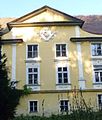Hochscharten Castle
The Castle Hochscharten was located in the district of the municipality Inzing Waizenkirchen in Grieskirchen in Hausruckviertel of Upper Austria. It was demolished around 2010.
history
Hochscharten Castle dates from the beginning of the 19th century. It emerged from a farm, the Hochschartnergut, which was originally the Meierhof of the noble estate Inzing . The former keeper of Weidenholz Castle, Johann Saxinger, had the courtyard converted into a two-story residential building. His successor was the community doctor Karl Esterle, who set up another floor and added a clock tower. In 1864 the property was sold to Freiherr Gustav von Krieg, a brother-in-law of the Austrian field witness Ludwig August Ritter von Benedek, who was unhappy against the Prussians in the Battle of Königgrätz . In 1868 the property was sold to Count Johann Taxis von Bordogna-Valsassina. He had the castle extended by two side wings, so that a castle courtyard was created against the hill. His son Hans sold the castle to Count Botho Coreth in 1896 . In 1910 he had the previous flat roof replaced by the hipped roof that still exists today. Above the castle, a building was built for the count's horses, which is incorrectly referred to as Inzing Castle. In 1942, after Botho Coreth's death, the Hochscharten family had to sell.
For a short time, the castle served as a maternity hospital. From 1945 it was used as a barracks by the American occupation forces. Between 1954 and 1957, Hochscharten belonged to the Chamber of Commerce for Upper Austria , which maintained a boarding vocational school there. The other owner since 1988, the industrialist Robert Wimmer from Wels, is known as a supporter of the right-wing extremist scene, as he made Hochscharten Castle available as a training location for the “Friends of Culture and Contemporary History”. The castle was recently sold to a real estate developer from Peuerbach.
Hochscharten Castle today
Hochscharten Castle was a three-storey, three-winged building with a gable mansard, which was located on the side facing the park. Below the empty gable was a stucco cartouche showing the coat of arms of Upper Austria. The tall windows were framed with stucco. The facades were structured by stucco half-columns. Another dividing element of the facade was a ledge that separated the two upper floors from the lower one, which was a little simpler.
The castle was in a spacious park. Since the last palace gardener retired, the palace and park had been in a neglected and overgrown condition. Due to the trees, the view of the inner courtyard of the palace was hardly possible.
Around 2010 the regional entrepreneur Haslehner bought the castle and wanted to turn it into a residential building. However, since the state of construction was too bad, the whole castle was demolished and a new building was built in its place.
literature
- Eva Berger : Historic gardens of Austria: Upper Austria, Salzburg, Vorarlberg, Carinthia, Styria, Tyrol. Volume 2, Böhlau, Vienna 2003, ISBN 3-205-99352-7 .
- Norbert Grabherr : Castles and palaces in Upper Austria. A guide for castle hikers and friends of home. 3rd edition . Oberösterreichischer Landesverlag, Linz 1976, ISBN 3-85214-157-5 .
- Oskar Hille: Castles and palaces in Upper Austria then and now. Verlag Ferdinand Berger & Sons, Horn 1975, ISBN 3-85028-023-3 .
Web links
- Entry via Schloss Hochscharten to Burgen-Austria
- Hochscharten Castle on the homepage of the community Waizenkirchen
Individual evidence
- ^ Eva Berger, 2003.
- ↑ Inzing Castle
- ^ Chronicle of the Altmünster vocational school
- ↑ Right-wing extremism & neo-Nazism in Wels ( Memento of the original from April 6, 2012 in the Internet Archive ) Info: The archive link has been inserted automatically and has not yet been checked. Please check the original and archive link according to the instructions and then remove this notice.
- ↑ Written parliamentary question from the members of the Nationalrat Anschober, Freundinnen und Freunde of February 18, 1997, No. 2002 / J, to the Federal Minister of the Interior (PDF; 24 kB)
- ↑ DÖW: neo-Nazi meeting dissolved ( memento of the original from January 21, 2016 in the Internet Archive ) Info: The archive link has been inserted automatically and has not yet been checked. Please check the original and archive link according to the instructions and then remove this notice.
Coordinates: 48 ° 19 ′ 57.3 " N , 13 ° 51 ′ 45.7" E




